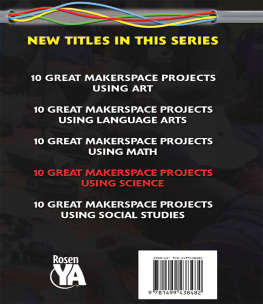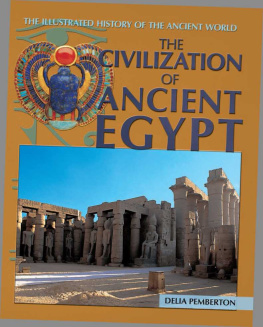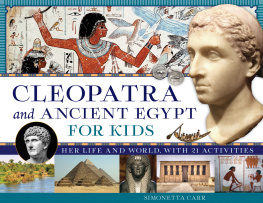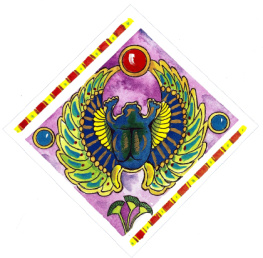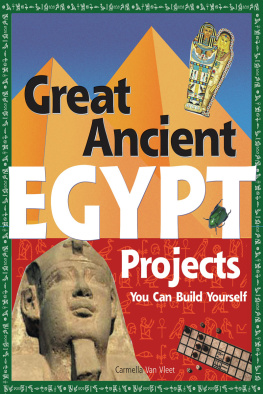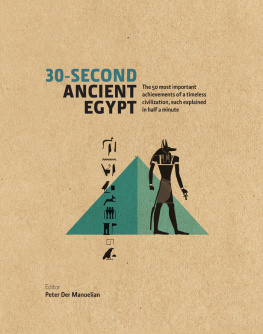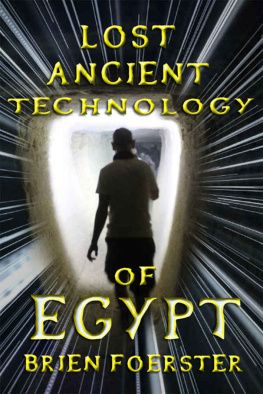

Published in 2015 by Britannica Educational Publishing (a trademark of Encyclopdia Britannica, Inc.) in association with The Rosen Publishing Group, Inc.
29 East 21st Street, New York, NY 10010
Copyright 2015 The Rosen Publishing Group, Inc. and Encyclopdia Britannica, Inc. Encyclopdia Britannica, Britannica, and the Thistle logo are registered trademarks of Encyclopdia Britannica, Inc. All rights reserved.
Distributed exclusively by Rosen Publishing.
To see additional Britannica Educational Publishing titles, go to http://wwww.rosenpublishing.com.
First Edition
Britannica Educational Publishing
J. E. Luebering: Director, Core Reference Group
Anthony L. Green: Editor, Comptons by Britannica
Rosen Publishing
Hope Lourie Killcoyne: Executive Editor
Jacob R. Steinberg: Editor
Nelson S: Art Director
Brian Garvey: Designer
Cindy Reiman: Photography Manager
Library of Congress Cataloging-in-Publication Data
Staley, Erin, author.
Discovering ancient Egypt/Erin Staley.First edition.
pages cm.(Exploring ancient civilizations)
ISBN 978-1-6227-5827-2 (eBook)
1. EgyptCivilizationTo 332 B.CJuvenile literature. 2. EgyptCivilization332 B.C.-638 A.D.Juvenile literature. 3. EgyptAntiquitiesJuvenile literature. I. Title. II. Series: Exploring ancient civilizations.
DT61.S858 2014
932.01dc23
2014025955
Photo credits: Cover, pp. 1, 3 Dudarev Mikhail/Shutterstock.com; p. 7 Sophie McAulay/Shutterstock.com; p. 9 nicolas lecoz/Fotolia; p. 10 Bob Burch/Bruce Coleman Inc.; pp. 12, 18 DEA/G. Dagli Orti/De Agostini/Getty Images; pp. 13, 16 Hirmer Fotoarchiv, Munich; p. 17 Print Collector/Hulton Archive/Getty Images; p. 21 uwimages/Fotolia; p. 23 Photos.com/Jupiterimages; p. 25 DEA/W. Buss/De Agostini/Getty Images; p. 26 Top Photo Corporation/Thinkstock; p. 27 moonfish8/Shutterstock.com; p. 28 Private Collection / The Stapleton Collection / Bridgeman Images; p. 31 Encyclopedia Britannica, Inc.; p. 32 Waj/Shutterstock.com; p. 34 A. DEA/A. Dagli Orti/De Agostini/Getty Images; p. 37 Heritage Images/Hulton Archive/Getty Images; p. 40 Zoran Karapancev/Shutterstock.com; p. 41 Universal Images Group/Getty Images; p. 42 Philippe Huguen/AFP/Getty Images; cover and interior graphics iStockphoto.com/ksana-gribakina (patterned banners and borders), HorenkO/Shutterstock.com and Freckles/Shutterstock.com (background textures).
CONTENTS
M assive pyramids, famous mummies, and mysterious tombsthese are just a few of the fascinating elements of one of the most celebrated civilizations in history: ancient Egypt. This civilization was established along the banks of the Nile River about 5,000 years ago. Early Egyptians were nomads who found that the river valley offered everything they needed to prosper. They built communities, and as the people flourished, so did their civilization.
From writing to religion, the ancient Egyptians left a legacy for future civilizations to admire and copy. Egypt is credited with making paper; creating the first-known solar calendar; refining scientific, mathematical, and agricultural techniques; developing irrigation systems; and establishing a government that lasted for more than 3,000 years. Ancient Egypt was the superpower of its time. Nonetheless, like other giants of the ancient world, it eventually perished. Climate, corruption, and foreign invaders all played a part in the demise of this notable society. However, ancient Egypts legacy and achievements continue to capture our imaginations and inspire the arts and sciences to this day.
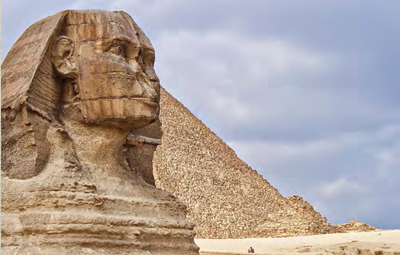
Carved about 2500 BCE, the Great Sphinx stands before the pyramid complex in Giza, Egypt, and is one of the most recognizable symbols of ancient Egypt. It measures 172 feet (52.4 meters) in length and 66 feet (20 meters) in height.
In what follows, we will explore the early settlement of ancient Egypt. Well discover how they built their society and set standards in every aspect of civilization. Well also visit the most exciting moments of Egyptian history and touch on its most famous pharaohs. Finally, well look at the immeasurable mark ancient Egypt has left on our culture today.
F or more than 10,000 years, hunters and gatherers roamed the Nile valley in northeastern Africa. A swampy plateau overgrown with trees, rushes, and papyrus, the narrow valley was home to the worlds longest river, the Nile. As the climate became hot and dry, harsh desert conditions developed on either side of the 4,132-mile-long (6,650 kilometer) river. The Nile became the only oasis for drinking water, food, and transportation. Eventually it became what the ancient Egyptians believed to be the gateway to the afterlife.
This dependency on the Nile, both physical and spiritual, is reflected in the first verses of the ancient Hymn to the Nile: Hail to thee, O Nile! Who manifests thyself over this land, and comes to give life to Egypt! The formerly nomadic Egyptians established villages and towns along its riverbanks. The time of this settlement is known as the Predynastic Era (5th millennium BCE C . 2925 BCE ). It would be the origins of one of antiquitys most important civilizations: ancient Egypt.
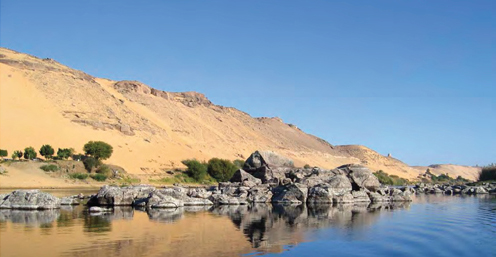
Known for being the longest river in the world, the Nile rises just south of the equator and flows northward through northeastern Africa. Its waters drain into the Mediterranean Sea.
Agriculture and Dietary Habits
In order to control the Nile, the ancient Egyptians invented a year-round irrigation system. It sent river water along short canals to nearby fields. With an ongoing watering system, farmers could plant seeds and grains. They developed a measuring system that allowed them to plant such crops as wheat and barley. These ingredients were used to make such Egyptian staples as bread, soup, and beer. The ancient Egyptians also used the land to domesticate long-horned cattle, sheep, goats, and geese. These animals provided food, and the cattle also supplied labor to plow the fields and carry heavy loads.
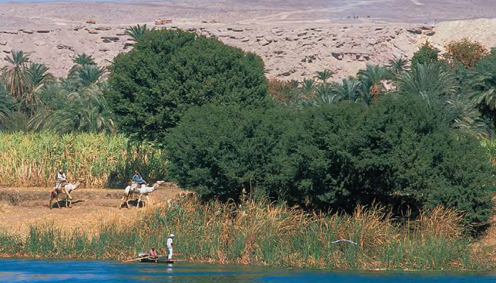
About 96 percent of Egypts total area is desert. To aid in the cultivation of produce, farmers use irrigation on the banks of the Nile River. This practicewhich is still used todaydates back to ancient times.
Ancient Egyptian Artisans
The ancient Egyptians were skilled artisans. They used nearby resources to build homes, make clothing, and craft home goods. The first Egyptian homes were lightly built huts. However, later homes were made of mud bricks and more sophisticated. They had wood-framed doors, small windows, and floors of straw matting. Paintings often decorated the walls, and although wood was scarce, it was eventually imported from other lands to make furniture.
CIVILIZATIONS FIRST SOLAR CALENDAR
Egyptian farmers set out to predict the Niles flooding cycle. They wanted to determine when the ideal planting season would come each year. In approximately 4236 BCE , they created a 365-day agricultural calendar. This was the first solar calendar consisting of 365 days in recorded history. The Egyptian calendar consisted of 12 months. Each month was made up of 30 days. An additional five days were added at the end of each year to keep calendar dates better aligned with the suns movement. The calendar year was divided into three seasons: the inundation (flooding season), winter (when the waters receded), and summer (the dry season or harvest). The agricultural calendar made it possible for farmers to harvest a high yield of annual crops.



